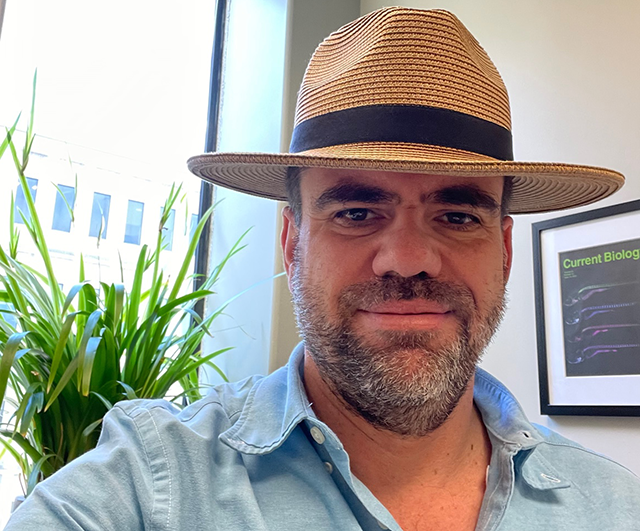
Michel Bagnat, Ph.D. (EMBL, Heidelberg)
Professor of Cell Biology, Nanaline Duke Distinguished Professor in the School of Medicine
Email: michel.bagnat@duke.edu
333B Nanaline Duke Bldg., Box 3709
Duke University Medical Center
Durham, NC 27710
Telephone 919-681-9268
Fax 919-684-5481
Cellular Mechanisms Controlling Organ Formation and Physiology
Our laboratory is interested in studying how basic cellular processes define the morphogenesis and physiology of organs. The research follows multidisciplinary approaches including genetics, microscopy, biophysical manipulations, and modeling. We seek to uncover mechanisms that define the mechanical properties of the antero-posterior axis and control protein absorption in the intestine and its systemic effects.
Using zebrafish and mouse models we investigate:
1-Cellular and biophysical mechanisms controlling antero-posterior (AP) axis development. Specifically, how the pressure generate by notochord vacuolated cell inflation drives AP axis elongation and defines the mechanical properties and development of the notochord and spine.
2-Mechanisms regulating volume control and tissue-wide coordination in vivo.
3-Mechanisms controlling precise and sequential segmentation of the notochord and spine.
4-Cellular mechanisms controlling dietary protein uptake and absorption in the zebrafish and neonatal mammalian gut.
Recent Publications:
Wopat S., Adhyapok P., Daga B., …, Kiehart D., Charbonneau P., Bagnat M. (2024) Notochord segmentation in zebrafish controlled by iterative mechanical signaling. Developmental Cell. (link)
Brianna Peskin, James Norman, Jennifer Bagwell, Adam Lin, Priyom Adhyapok, Stefano Di Talia, Michel Bagnat. (2023) Dynamic BMP signaling mediates notochord segmentation in zebrafish. Current Biology. (link)
Zhou K. C., Harfouche M., Cooke C. L., …, Bagnat M., Hortmeye R. (2023) Parallelized computational 3D video microscopy of freely moving organisms at multiple gigapixels per second. Nature Photonic. (link)
Bagnat M, Daga B, Di Talia S. (2022) Morphogenetic Roles of Hydrostatic Pressure in Animal Development. Annu Rev Cell Dev Biol. (link)
Levic DS, Ryan S, Marjoram L, Honeycutt J, Bagwell J, Bagnat M* (2020) Distinct roles for luminal acidification in apical protein sorting and trafficking in zebrafish. JCB (Link).
Bagwell J, Norman J, Ellis K, Peskin B, Hwang J, Ge X, Nguyen S, McMenamin SK, Stainier DYR, Bagnat M* (2020) Notochord vacuoles absorb compressive bone growth during zebrafish spine formation. eLife (Link).
Park J, Levic D, Sumigray K, Bagwell J, Eroglu O, Block C, Eroglu C, Barry R, Lickwar C, Rawls J, Watts S, Lechler T, Bagnat M (2019) Lysosome-Rich Enterocytes Mediate Protein Absorption in the Vertebrate Gut. Developmental Cell 51, 1-14.
Wopat S, Bagwell J, Sumigray KD, Dickson AL, Huitema LFA, Poss KD, Schulte-Merker S, Bagnat M* (2018) Spine patterning is guided by segmentation of the notochord sheath. Cell Reports 22(8): 2026-2038.
Garcia, Jamie, Bagwell, Jennifer, Njaine, Brian, Norman, James, Levic, Daniel S., Wopat, Susan, Miller, Sara E., Liu, Xiaojing, Locasale, Jason W., Stainier, Didier Y.R., Bagnat, Michel. (2017). Sheath Cell Invasion and Trans-differentiation Repair Mechanical Damage Caused by Loss of Caveolae in the Zebrafish Notochord. Current Biology. 0960-9822.
Cao J, Navis A, Cox BD, Dickson AL, Gemberling M, Karra R, Bagnat M, Poss KD. (2016). Single epicardial cell transcriptome sequencing identifies Caveolin 1 as an essential factor in zebrafish heart regeneration. Development 143(2): 232-43.
***Marjoram L, Alvers A, Deerhake ME, Bagwell J, Mankiewicz J, Cocchiaro J, Beerman RW, Willer J, Katsanis N, Tobin DM, Rawls JF, Goll M, Bagnat M (2015). Epigenetic control of intestinal barrier function and inflammation in zebrafish. Proc Natl Acad Sci USA. 112:2770-75.
Marjoram L, Bagnat M. (2015). Infection, Inflammation and Healing in Zebrafish: Intestinal Inflammation. Curr Pathobiol Rep. 1;3(2):147-153.
Rodríguez-Fraticelli AE, Bagwell J, Bosch-Fortea M, Boncompain G, Reglero-Real N, Andrés G, Alonso MA, Millán J, Perez F, Bagnat M and Martín-Belmonte F (2015). Developmental regulation of apical endocytosis controls epithelial patterning in vertebrate tubular organs. Nat. Cell Bio. 17:241-50.
Navis A, Bagnat M. (2015). Developing pressures: fluid forces driving morphogenesis. Curr Opin Genet Dev. 32:24-30.
Navis A and Bagnat M (2015). Loss of cftr function leads to pancreatic destruction in juvenile zebrafish. Dev. Bio. 2:237-248.
Alvers AL, Ryan S, Scherz PJ, Huisken J, Bagnat M (2014). Single continuous lumen formation in the zebrafish gut is mediated by smoothened-dependent tissue remodeling. Development. 141:1110-1119.
Gray RS, Wilm TP, Smith J, Bagnat M, Dale RM, Topczewski J, Johnson SL, Solnica-Krezel, L (2014). Loss of col8a1a function during zebrafish embryogenesis results in congenital vertebral malformations. Dev. Biol. 386:72-85.
Ryan S, Willer J, Marjoram L, Bagwell J, Mankiewicz J, Leshchiner I, Goessling W, Bagnat M, and Katsanis N (2013). Rapid identification of kidney cyst mutations by whole exome sequencing in zebrafish. Development. 140:4445-4451.
Ellis K, Hoffman BD, Bagnat M (2013). The vacuole within: How cellular organization dictates notochord function. Bioarchitecture. 26;3(3).
Ellis K, Bagwell J, Bagnat M (2013). Notochord vacuoles are lysosome-related organelles that function in axis and spine morphogenesis. J. Cell Biol. 200(5):667-679.
**This article is featured in:In Focus: Notochord vacuoles make a rod for the vertebrate back. J Cell Biol. 200(5):553- and: SCIENCENOW: and: Science in the Clouds
Click here for a full list of Publications.